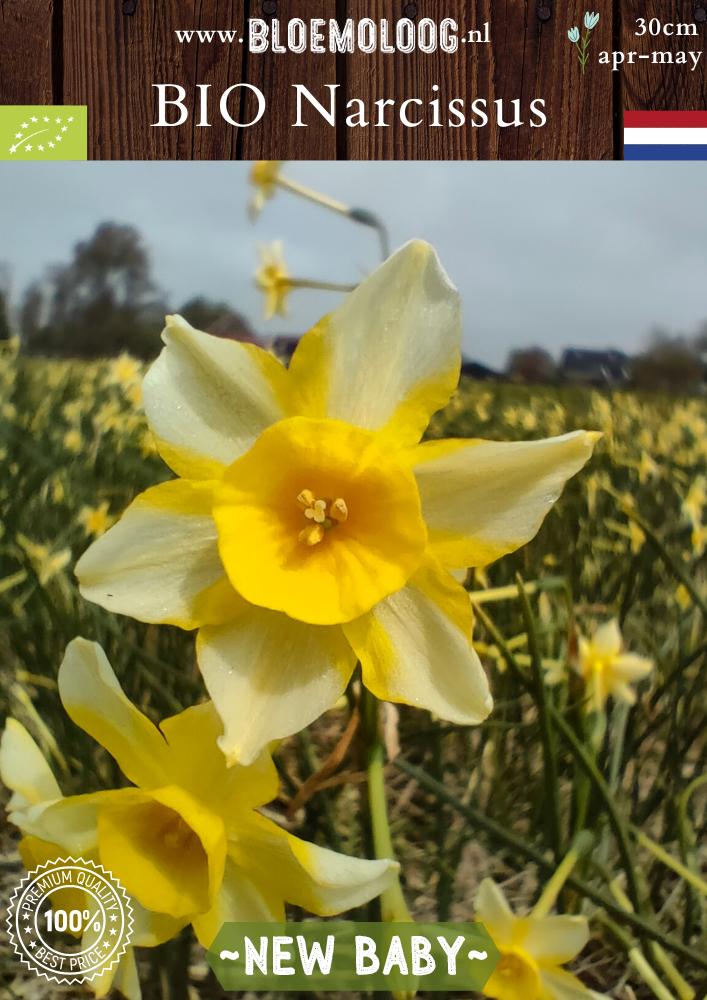Bloemoloog
Estimated Shipping Widget will be displayed here!
Couldn't load pickup availability
Organic jonquilla daffodils
The Narcissus jonquilla 'New Baby' belongs to the trumpet daffodils and is distinguished by its small size and delicate appearance. The flowers are quite small compared to other daffodils and are one of the last daffodils to bloom. It grows to a height of about 20 to 30 centimeters with several flowers per flower stem. Each flower has a yellow trumpet-shaped corolla surrounded by soft, cream-colored petals.
The compact and abundant flowering of the Narcissus 'New Baby' makes it perfect for borders, rock gardens, pots and containers. In addition, the flower spreads a pleasant scent that fills gardens with a wonderful perfume.
How, where and when do I plant daffodil bulbs?
A daffodil flower bulb needs a cold period, so plant it in the ground from September to January. The planting depth is 2 to 3 times the height of the flowerbulb itself and the planting distance is 2 to 3 times the width of the flowerbulb itself. When planting in pots, the flowerbulbs may be planted closer together and may extend half above the ground for a decorative effect. However, after flowering, the flower bulbs should be planted back in the garden, while maintaining the planting depth and spacing discussed.
Plant the daffodil 'New Baby' in a sunny to semi-shaded spot in the garden, pot or lawn. Plant it in groups in a nutrient-rich, water-permeable, preferably calcareous, sandy soil.
Daffodil bulbs are poisonous, which is why they are avoided by rodents such as voles. Use them as a natural protection for other flowerbulbs by planting them around and between the other bulbs.
Care of the daffodil
Provide organic nutrition during planting. Cut off the spent flowers at the top and let the rest of the foliage die. Only cut it off when the leaf has completely dried out. The jonquilla 'New Baby' is a strong species that naturalizes well. She comes back every year faithfully. Provide organic food annually for optimal results.
Propagation
For propagation, the flower bulb can be dug out at the beginning of summer. The flower bulb is dried and stored in a warm place. They can be planted again from September. Plant the small bulbs separately and provide organic nutrition so that the small flower bulbs grow quickly.
Origin of the daffodil
The ‘New Baby’ daffodil is relatively new compared to classics such as Narcissus poeticus ‘Recurvus’. This cultivar originated from a jonquilla daffodil.
Buy Organic Narcissus 'New Baby'
Skal NL-BIO-01 certified: 109459
Packed per 10 flower bulbs or choose a stacking discount!
Stacking discount: E
Can be ordered from June '25!
EU shipping €8.95 - Free shipping from €100 purchase.
Characteristics
| Flowering time: | April - May |
| Planting time: |
From September |
| Planting depth: |
10 cm deep |
| Planting distance: | 10 cm apart |
| Height: |
30 cm high |
| Flower diameter: |
5 cm wide |
| Location: |
Partial shade, sun |
| Soil PH: | Clay, loam, sandy soil - Slightly acidic/neutral |
| Winter hardiness: |
Very hardy |
| Propagation: | Good (naturalizes) |
| Family: |
Amaryllidaceae (daffodil family) |
| Group: | Botanical |
| Colour: |
Light yellow |
| Bee-friendly: | Yes |
| Fragrant: | Yes |
| Bulb size: | 8/9 |
Other daffodil varieties

NL-BIO-01
To share






